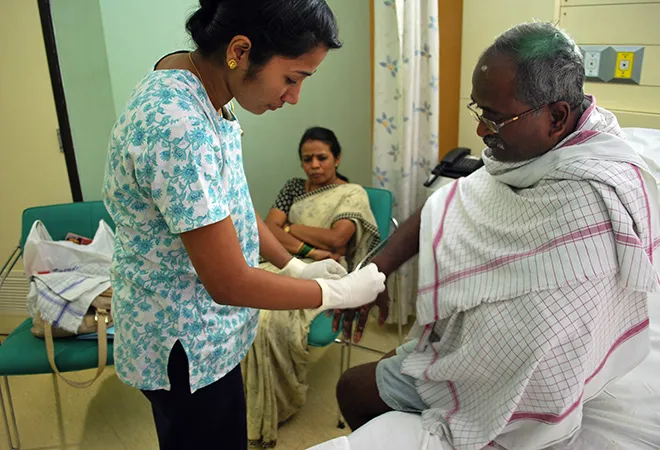Earlier this year, around 200 countries came together and agreed in principle on a global indicator framework for the 2030 Agenda and the Sustainable Development Goals (SDG). The 17 goals and 169 targets of the SDG framework will be complemented by 230 indicators, which is a jump by five-times from the millennium development goals (MDG) era, which had 48 indicators. India’s ministry of statistics (MoSPI) and NITI Aayog are currently in the process of integrating the SDGs into national planning processes and finalising the national indicator framework.
As India implements SDGs, official estimates reveal that India has achieved the poverty goal of the previous set of millennium development goals (MDG). India more than halved the number of poor by 2015 successfully. However, India has not yet succeeded in attaining the goals linked with manifestation of extreme poverty. Issues of hunger, malnutrition, women dying in childbirth and children who die young have not been tackled as successfully as poverty. India’s infant mortality rate (IMR) is still around 40 while China has brought theirs down to under 10.
The new national family health survey (NFHS) 4, which for the first time gives district level data and will repeat every three years according to plans, will doubtlessly help overcome some data bottlenecks. NFHS 4 replaces the annual health survey (AHS) and district level household and facility survey (DLHS) — two major sources of health data at the district level during the MDG era.
However, unavailability of regular, good-quality data remains a binding constraint in health and nutrition policy in the country. This has an impact on the general quality of discussions as well. While district level indicators are the need of the hour, India does not even have regular IMR or maternal mortality ratio (MMR) numbers for all the states.
< style="color: #163449;">Health situation in India
Despite being sensitive indicators of a country’s health status, high IMR and MMR represent only the tip of the real problem. It is estimated that more than 60 million people are pushed into poverty every year in India because of healthcare payments — that’s 122 per minute or 52.5 lakh per month — a staggering statistic by any standard. Indians represent more than 60% of the global figure. Malnutrition presents a formidable policy challenge as well: by some estimates, the economic burden of malnutrition is expected to be between 0.8% and 2.5% of India’s overall GDP.
At the same time, when we look only at present levels and not the distance covered, we run the risk of understating our own achievements. As Angus Deaton explains, India’s steady decline in infant mortality is remarkable also because it was not at all affected by economic growth. Between 1950 and 2010, the absolute decline in IMR from 165 to 53 was actually larger in absolute numbers than the decline in China, from 122 to 22. While it is still more dangerous to be born in India than in China, Deaton argues that India’s health performance is not obviously inferior to China’s. An important point missing in many discussions is that India’s success in health outcomes was also achieved without the degree of coercion and loss of freedom associated with Chinese initiatives.
UN has termed the dramatic decline of IMR in the past quarter of a century as one of the most significant achievements in human history, in which India had a major part. Although India may have failed to achieve MDG 4 of reducing IMR to 27, as of 2013, 15 states/UTs had already achieved the goal, according to official estimates. The decline in IMR over the last few decades has been remarkable.
< style="color: #163449;">Inequalities within
While showing improvements over the past, India’s average health indicators hide stark inequalities within. Despite India’s consistent improvements in life expectancy, data between 1998-1999 and 2005-2006 showed that for poor adivasis, average life expectancy declined slightly, as research from the International Institute of Population Studies (IIPS) showed. Health outcome and access indicators show considerable disparities across socio-economic and regional categories.
The latest statistics about causes of death in India between 2010 and 2013, published after a gap of almost 10 years by the government of India in December 2015, painted a distressing picture. Between 2010 and 2013, Bihar, Jharkhand, Uttar Pradesh, Uttarakhand, Madhya Pradesh, Chhattisgarh, Orissa, Rajasthan and Assam put together had more than 20% of all their deaths happening between 0-4 age group. For other states, the proportion was 9.3%. The states in question are also home to more than half of all Dalits, Adivasis and Muslims in the country.
Similarly, the same set of states had 42% of all female deaths happening because of communicable, maternal, perinatal and nutritional conditions. In other states, the proportion was a much lower 24%. While 11.8% of all male deaths happen between the 0-4 age group, the proportion for females is an alarming 13.3%. Deaths by diarrhoeal diseases as a proportion of total deaths is more than 50% higher for females than males. All these point towards the need to collect disaggregated data and to regularly track health at more disaggregated levels.
< style="color: #163449;">Private sector: the fatal blind spot?
In the past, India’s administrative data system used to provide reliable numbers for social sectors, as the private sector was small or negligible. However, in the last three decades, private participation in social sectors exploded. As Pronab Sen puts it, with a considerably large proportion of the citizens going to the private sector to receive services, the coverage and significance of administrative data as a reliable indicator of these sectors has declined. The education sector adapted quickly with government initiatives like District Information System for Education (DISE) collecting regular data covering the private sector as well. Given the severe under-regulation prevalent in the healthcare sector, possibility of even the regulatory records emerging as an alternative source of reliable data seems grim.
Also, the quality of data in the administrative system is a concern — for example, given the incentive structures, data collectors are often conscious that the same data could be used against them. Even if such challenges are overcome, unless India has a suitable health management information system also covering the private sector, the role of HMIS as a decision making tool will be limited. Therefore, most of the health policymaking is informed by data collected through large sample surveys.
Nevertheless, national sample survey (NSS) which was set up in 1950 to bridge large gaps in statistical data needed for planning and policy formulation, still does not give district level estimates. Health related data that are collected by NSS through what is commonly known as ‘central sample’ data, are a major source for policy research in the country. The data is regularly analysed and put in the public domain by MoSPI, and unit level data made available for a fee.
Considerable resources are also spent to collect what is known as the ‘state sample’, which covers at least a matching number of respondents in each state. Pooling of central and state samples will enhance the policy relevance of NSS data, as the data then can be used to arrive at district level estimates. There have been discussions around pooling of NSS data, but nothing concrete seems to have happened.
It is widely accepted by now that the MDG framework of vertical goals contributed to fragmented approaches to development. The sustainable development goals framework offers to overcome this anomaly by introducing a broader set of goals. Tracking these goals is going to be a daunting challenge for governments, international agencies as well as national statistical offices. A ‘data revolution’ is needed in terms of making available disaggregated data if India is to achieve — or get anywhere near — the ambitious SDGs related to health and nutrition.
This commentary originally appeared in The Wire.
The views expressed above belong to the author(s). ORF research and analyses now available on Telegram! Click here to access our curated content — blogs, longforms and interviews.




 PREV
PREV


